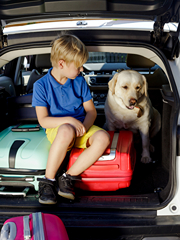What Kids Should Know About Emergency Situations in a Car
As a parent, teaching your children how to respond during an emergency is an invaluable life skill. While we all hope that our car rides will be safe and routine, it’s essential for kids to know what to do if things go wrong. From staying calm to understanding basic safety practices, education is the key to safety.
This guide provides helpful tips to empower your kids during an emergency situation in a vehicle.
1. Staying Calm in an Emergency
The first and most important lesson for kids in any emergency is to stay calm. Panicking can make a situation worse, and remaining composed helps them think clearly and follow instructions. Explain to your children that taking deep breaths can help reduce anxiety and keep them focused. Remind them that emergencies are rare, and that they can trust adults, including emergency responders, to keep them safe.
2. Learning Basic Emergency Contacts
Kids should know who to contact during an emergency, especially if an adult cannot make the call. Teaching them how to dial emergency numbers like 911 is crucial. Make sure they understand when it’s appropriate to make the call. Practicing what to say to a dispatcher—such as their location, the nature of the emergency, and who else is with them—can give them confidence if they ever need to reach out for help.
Another helpful tip is teaching them to share their location if they are old enough to understand. For example, they should know how to identify landmarks or use a smartphone if available.
3. Car Safety Essentials Every Kid Should Know
While you’re teaching your kids about emergency preparedness, it’s a great time to go over general car safety basics. Teach them the importance of always wearing a seatbelt and keeping it buckled throughout the drive. Explain that the safest place for younger kids is in the back seat, away from airbags, which can be harmful to smaller passengers.
If an accident or sudden stop occurs, remind them not to unbuckle their seatbelt until it’s safe. Seatbelts are one of the most critical safety tips to help protect them in case of a collision, so reinforcing this message is key.
4. What to Do in a Car Accident
In the unfortunate event of a car accident, children should know to stay calm and follow the adult’s instructions. Explain that in an accident, it’s best for everyone to remain in their seats unless it’s necessary to exit the car for safety.
If there is a need to leave the vehicle, make sure kids understand they should stay close to the car or in a safe area away from traffic. Remind them that, if they’re unsure, waiting for help to arrive is often the safest choice. It’s also helpful to explain the role of emergency services so kids know what to expect when firefighters, paramedics, or police arrive. If your family ever needs legal advice, a car accident attorney can provide information and support, ensuring your rights are protected and your family is cared for.
5. Keeping Your Vehicle Childproofed for Safety
Taking steps to childproof your vehicle can also play a significant role in preventing accidents or injuries. For instance, make sure the child safety locks are activated so young children can’t accidentally open doors. Consider keeping child-friendly emergency items in the car, like a flashlight, first-aid kit, and extra water. These small actions can make a big difference in helping kids feel safe and secure on the road.
Additionally, ensure that any loose items are secured to avoid them becoming projectiles in the event of a sudden stop or accident. This is a simple but effective step toward making the vehicle safer for everyone on board.
6. Emergency Drills for Practice
Just as schools conduct fire drills, you can practice simple emergency drills at home or in a parked car. This could involve teaching kids how to unlock their seatbelt quickly, showing them where the emergency brake is (but advising them not to touch it unless necessary), or role-playing different scenarios to help them understand what steps to take.
Make these drills short and positive, emphasizing that it’s unlikely they’ll ever need to use these skills but that it’s always better to be prepared.
Empowering Kids with Confidence and Knowledge
Helping your kids learn what to do in a car emergency situation can give them the confidence and knowledge to stay safe. Knowing the basics—from calling for help to understanding why they should remain buckled up—empowers them to act responsibly if an emergency ever occurs. It’s about providing them with the tools they need to feel secure and aware, no matter where the road takes them.
With a few thoughtful conversations and safety practices, your family can feel ready for any scenario that might come your way.




